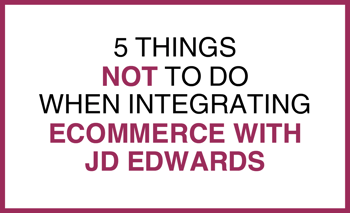5 Things Not to Do When Integrating eCommerce With JD Edwards
 An eCommerce and JD Edwards integration project can be a challenging undertaking for any organization. There are a ton of moving pieces, and a certain level of expertise is required for success. So where do you begin? Here are five things NOT to do in order to achieve eCommerce JDE integration success.
An eCommerce and JD Edwards integration project can be a challenging undertaking for any organization. There are a ton of moving pieces, and a certain level of expertise is required for success. So where do you begin? Here are five things NOT to do in order to achieve eCommerce JDE integration success.
1. Don’t Duplicate ERP Data Unless You Know Why
Data is the lifeblood of an eCommerce engine, and the data needed for an integration project typically already exists in the ERP. The whole point of an integration project is to have accurate data accessible throughout your system, and to do that you need to determine where each data element should be stored and which system “owns” the data. Careful consideration should be given to data points such as customer master data, item/catalog data, and customer order information.
After it is decided where each data point should reside, who owns it, and how it will be shared, a data map should be created so that ownership is clearly defined and documented. A great mantra to keep in mind is: “There can only be one source of the truth.” This will help to establish whether the eCommerce or ERP system should own the data.
2. Don’t Overlook the Value of JD Edwards Experience
This may seem like a no-brainer, but it’s worth mentioning. Not all ERPs are created equal, and just because a potential partner has ERP experience doesn’t mean they have JD Edwards experience. An integration can be a tricky project, so working with someone who knows the ins and outs of JD Edwards World and EnterpriseOne, and all that they are capable of, will certainly be helpful.
3. Don’t Work with a Partner Who Doesn’t Have a Clear Integration Strategy
So you’ve determined that your integration partner has JDE experience, but do they have an integration strategy? An integration can be tough and will probably get confusing at times, but a partner with a clear eCommerce integration strategy has that roadmap to reference along the way. Furthermore, an integration strategy based on experience will most likely anticipate and accommodate needs and issues that pop up throughout the project.
4. Don’t Half-Ass the Integration
Pardon our language, but there really is no better way to get this point across. When it comes down to it, a poorly-executed integration is worse than no integration at all, so commit the necessary resources to achieve the best possible integration.
A few good questions to keep in mind throughout the integration process are:
- Does integrating data make the customer’s experience easier than calling a customer service representative to get what they need?
- Does the integrated data negatively affect business-critical systems?
- Does the integration cause loading problems or slow down the site?
If the answer to any of those questions is “yes,” you need to rethink your plan. Integrating data at the sacrifice of other necessary business functions isn’t worth it. Instead, ensure that you’re completing the integration as thoroughly and successfully as possible. Cutting corners now will lead to big problems down the line.
5. Don’t Exclude Your JD Edwards Operations Team
You absolutely have to involve your JDE business operations team in your integration project. These are the people who know what business processes are needed to keep everything working well together within your company. These team members can even be considered an extension of customer service, so at the very least ensure that your customer service team is involved.
You can’t conduct an integration in a vacuum; there are too many other factors to consider to ensure you have a successful integration. Team members involved in operations, manufacturing, shipping, customer service, and marketing all need to be involved in different capacities throughout the project so that the solution works for your entire organization.
There are so many details to an integration project that it is easy to get overwhelmed by it all. Keep these tips in mind to avoid these mistakes and help your integration reach success.
Do you have an integration project that could use the help of our experienced team? Drop us a line.

